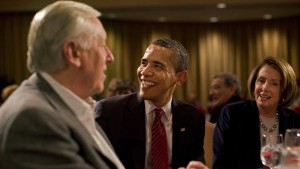
Raising the fuel economy standard for automakers avoids once again a much tougher political choice of raising the price of fuel paid for by voters.
President Obama will announce tomorrow that he is requiring new national standards on auto greenhouse gas emissions and fuel economy that will drastically increase the mileage required for new vehicles sold in the U.S.
The White House and the EPA declined to confirm this, but widespread news reports citing people who were briefed on the new plans leave little doubt that the gridlock caused by auto industry lobbyists on imposing higher mileage standards is about to be broken.
Under the new standard, the national fleet mileage rule for cars would be more than 40 miles a gallon in 2016. Light trucks would have to meet a fleet average of slightly than 26 miles a gallon by 2016.
Back in March, the Department of Transportation (DOT) issued new fuel economy standards for cars and light trucks for the 2011 model year. They raised the industry-wide combined average to 27.3 miles per gallon, a 2 mpg increase over the 2010 model year average, as estimated by the National Highway Traffic Safety Administration (NHTSA), which is part of DOT and is responsible for fuel economy regulations. The car standard for a 2011 is an average of 30.2 mpg. The 2011 light truck requirements average to about 24.1 mpg
The DOT release was silent back then on the proposed initiative in California to regulate greenhouse gases and effectively raise fuel economy standards far above what automakers said was technically possible. The proposal by the California Air Resources Board (CARB), 13 states and the District of Columbia to establish their own fuel economy and greenhouse gas programs continues to be controversial for its fragmenting of federal Fuel economy regulations. It requires a waiver from the Environmental Protection Agency to go forward, but during the Bush Administration the waiver was denied. All told, these states comprise more than 40% of the vehicles sold in the U.S. All automakers opposed a separate standard and said that national regulations, which their lobbyists had kept low or frozen for decades, were sufficient.
In question are the types of vehicles you will be allowed to buy, where you can buy them, and maybe even how much moret hey will cost. Critics said if the the California waiver is granted, some vehicles won’t be available in the stricter states, though consumers might buy them elsewhere and move them into banned areas, as many California dealers believe will happen, providing a boon for dealers in Oregon and Nevada. The exemptions for wealthy buyers in the California bill are also troubling. Also affected will be auto industry jobs, and the location of those jobs — here or overseas – in the midst of an economic collapse.
The President is going to end the dispute between differing state and federal standards by proposing one national standard that incorporates the tougher California limits. It is clear that auto industry no longer has the political power to stall improvements in efficiency. What is not clear is how the new standard fits into an overall national energy policy that almost certainly requires raising the price of the fuel that voters pay for.
The Energy Independence and Security Act (EISA) in 2007 promulgated by the Bush Administration amended the Energy Policy and Conservation Act (EPCA) by mandating that the model year (MY) 2011-2020 CAFE standards be set sufficiently high to ensure that the industry-wide average of all new passenger cars and light trucks, combined, is not less than 35 miles per gallon by 2020. This is a minimum requirement, since NHTSA must set standards at the maximum feasible level in each model year. NHTSA will determine whether that additional requirement calls for establishing standards that reach the 35 mpg goal earlier than 2020. The Administration is now prepared to use that power to resolve the conflict. The real question remains just how difficult reaching the higher mileage requirements will be. More tonight and tomorrow from the Detroit Bureau.com
